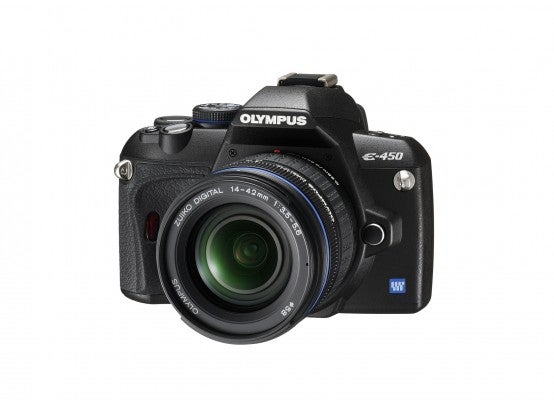Is the Olympus E-450 just a minor refresh or a feature-filled model worth considering? What Digital Camera reviews the latest entry-level DSLR in the Four Thirds system.
Olympus E-450 Review
Olympus E-450 features
The E-450 is Olympus’s 13th DSLR in its Four Thirds system, with its specification closely following that of the previous E-420 model. There are only a handful of differences between the two, chief among which concern the processor, the LCD screen and the addition of Art Filters functionality.
The processor is perhaps the most significant of the three, being the same TruePic III+ engine seen in the recent E-30 and E-620 models. Olympus claims that this facilitates ‘true-to-life image reproduction while reducing noise and enhancing processing speed’, and it works together with the 10MP LiveMOS sensor to produce images in both Raw and JPEG formats. While the 3.5fps frame rate of the E-420 has remained the same, the camera can now shoot eight images in a single burst without dropping this pace, in comparison to the E-420’s six.

The 2.7in HyperCrystal II LCD screen has also been made brighter to match the performance of its more expensive E-620 and E-30 siblings. It boasts a 176° viewing angle, and is said to maintain sharpness and contrast even when viewed in harsh sunlight. Its size falls a little short of the three inches we’ve seen on recent DSLRs, though presumably squeezing in a larger LCD screen – given the 4:3 aspect ratio of its images – would be tricky without compromising on the size of the camera.
The third change is the addition of Olympus’s Art Filters, although rather than the six seen on previous models there are only three. These are Pop Art, Pinhole and Soft Focus, and are accessed by the mode dial which houses all other exposure settings. A more minor change comes with the camera’s spot metering circle, which now takes its reading from 2% of the scene, rather than 1% as on the E-420.
Aside from these alterations, the camera is essentially the same as the E-420. Sensitivity is offered over a range of ISO 100-1600 in full stop increments, with noise-reduction options for long exposures and high-sensitivity images. Metering, meanwhile, comprises evaluative, centreweighted and spot patterns, together with highlight and shadow spot modes for metering more accurately in tricky conditions, while Shadow Adjustment technology works to optimise images for shadow and highlight detail.
The focusing system is fairly rudimentary in that it offers just three points across the horizontal, with 11 coming into play when the camera’s live view system is called upon. From here, the user has a number of options for focusing; the AF Sensor mode uses the standard autofocus sensor, dropping the mirror to focus before an image is taken, while the Imager AF mode uses the main imaging sensor for the same task. This latter option is the slower of the two, but has the advantage of showing you exactly what the camera is focusing on and with no interruption to the feed. The Hybrid AF mode introduced on the E-420 is also present, which uses a combination of the two for speed and accuracy. Should you want to, however, you can forgo all of these options for simple manual focusing.
As with every other Olympus DSLR, the E-450’s Supersonic Wave Filter uses a vibratory mechanism to shake any dust from the low-pass filter, which at default activates itself upon each powering up of the camera.
There are many other useful features on the E-450. If you’ve taken an image simultaneously in Raw and JPEG formats, you can choose to delete either the Raw or the JPEG version independently without having to sacrifice the other – ideal when running out of memory card space. Wireless flash is offered for controlling up to three groups of flashes, and you can also set the ppi output, saving you from having to resize your images in post-production. Finally, in addition to the ComapctFlash card slot the camera also accepts xD media, which can handily be used as an overflow.







